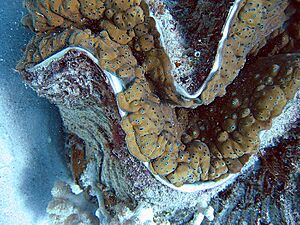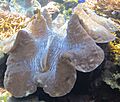Giant clam facts for kids
Quick facts for kids Giant clam |
|
|---|---|
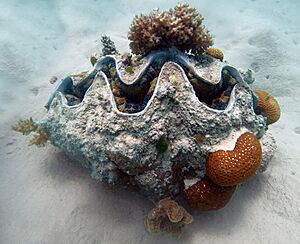 |
|
| T.gigas, Michaelmas Cay Great Barrier Reef, Queensland, Australia |
|
| Conservation status | |
| Scientific classification | |
| Genus: |
Tridacna
|
| Species: |
gigas
|
| Synonyms | |
|
Chama gigantea Perry, 1811 |
|
The giant clam, also known as Tridacna gigas, is the biggest living bivalve mollusk on Earth! These amazing creatures live in the shallow coral reefs of the South Pacific and Indian oceans. They can grow to be super heavy, weighing over 200 kilograms (about 440 pounds), and measure up to 120 centimeters (about 4 feet) across. Giant clams can live for more than 100 years in the wild. You can also find them near the Philippines and in the South China Sea around Malaysia.
Giant clams usually live in sandy areas or broken coral, sometimes as deep as 20 meters (66 feet). They are found across the Indo-Pacific region. Sadly, their numbers are shrinking fast, and they have disappeared from many places where they used to be common. Their quick growth is likely because they can grow algae inside their bodies.
When they are young, giant clams float around as tiny larvae. But as they grow up, they settle down and stay in one spot. The clam's soft body parts, called mantle tissues, are home to tiny, single-celled algae called zooxanthellae. These algae are like tiny food factories for the clam. During the day, the clam opens its shell and spreads out its mantle tissue. This allows the algae to get the sunlight they need to make food through photosynthesis. This special partnership gives the adult clams most of their nutrition.
Contents
Anatomy
It can be tricky to tell young giant clams apart from other types of giant clams. However, adult T. gigas are unique because they cannot close their shells all the way. This means you can always see part of their brownish-yellow mantle.
The Tridacna gigas shell has four or five vertical folds. This is a key way to tell it apart from a similar clam, T. derasa, which has six or seven folds. Giant clams grow their shells using a process called biomineralization, which is similar to how corals build their structures from calcium carbonate. This growth is affected by seasonal temperatures.
The edge of the clam's mantle is covered with hundreds or even thousands of tiny pinhole eyespots. Each spot is about half a millimeter wide and has a small opening like a pupil. These spots help the clam sense light. They can tell if the light is getting dimmer, changing direction, or if something is moving nearby. This allows the clam to partly close its shell if it senses danger.
Largest specimens
The biggest T. gigas ever found was about 137 centimeters (4.5 feet) long. It weighed 230 kilograms (510 pounds) after it died, but it was probably around 250 kilograms (550 pounds) when it was alive! This huge clam was found in 1817 off the coast of Sumatra, Indonesia. Its shells are now on display in a museum in Northern Ireland.
An even heavier giant clam was discovered in 1956 near Ishigaki Island in Japan. Its shell was 115 centimeters (3.8 feet) long, and it weighed 333 kilograms (734 pounds) when dead. It was estimated to weigh about 340 kilograms (750 pounds) alive!
Ecology
Feeding
Giant clams are filter-feeders, meaning they filter tiny bits of food from the water. However, most of their food (about 65-70%) comes from the tiny algae called zooxanthellae that live inside them. This special relationship helps giant clams grow so big, even in ocean waters that don't have many nutrients.
The clam's mantle edges are full of these helpful algae. The algae use things like carbon dioxide, phosphates, and nitrates that the clam provides. In return, the algae make food for the clam. In very small clams, filter feeding provides more of their food, but for larger clams, the algae become the main food source. The same type of algae can also live in both giant clams and nearby reef-building corals.
Reproduction
Giant clams start their reproduction process by releasing tiny eggs, which are about 100 micrometers wide. An adult giant clam can release more than 500 million eggs at one time!
Clams often release their eggs when the tide is coming in, especially around the full moon or new moon. They have contractions every few minutes, and the spawning can last from 30 minutes to over two hours. If a clam doesn't respond to its neighbors spawning, it might not be ready to reproduce.
Life cycle
After an egg is fertilized, it floats in the sea for about 12 hours. Then, a tiny larva hatches. This larva starts to grow a shell made of calcium carbonate. Two days after fertilization, it's only about 160 micrometers wide. Soon, it grows a "foot" that it uses to move around on the seabed. It can also swim to find a good place to live.
When the clam is about a week old, it settles down on the ocean floor. However, it might move around a lot during its first few weeks. At this stage, the larva doesn't have the symbiotic algae yet, so it relies completely on eating plankton. It also catches free-floating zooxanthellae while filtering food. Many small clams don't survive this stage. A clam is considered a juvenile when it reaches about 20 centimeters (8 inches) in length. In laboratories, giant clams have been seen to grow about 12 centimeters (5 inches) a year.
The way Tridacna clams grow so large, with their fleshy mantles extending beyond their shells, is quite unique among bivalves. Scientists believe this is due to a big change in how their bodies develop.
Human relevance
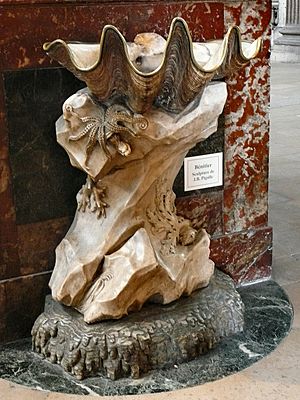

One of the main reasons giant clams are becoming endangered is too much fishing. Large adult clams are especially targeted because they are the most valuable.
Giant clam meat is considered a special food in places like Japan (where it's called himejako), France, Southeast Asia, and many Pacific Islands. Some Asian dishes use the meat from the clam's muscles. On the black market, giant clam shells are sold as decorations.
Legend
Because giant clams are so big, people have often misunderstood them throughout history.
Even in places where giant clams are common, stories sometimes describe them as dangerous. For example, a Polynesian folk tale tells of a monkey's hand being bitten off, and a Maori legend describes a clam attacking a canoe. In the 1920s, a science magazine called Popular Mechanics even claimed that these huge mollusks had caused deaths. Some versions of the U.S. Navy Diving Manual gave instructions on how to escape a clam's grip by cutting its muscles.
However, in reality, giant clams are not dangerous to humans. Their muscles close very slowly, and they need to push water out of their shells to close. This means they cannot trap a human.
Other myths suggest that giant clams live for an incredibly long time because of their huge size. While they do live a long time and can help scientists study past climate conditions, their large size is actually more linked to how fast they grow.
Aquaculture
People have started farming giant clams to help their populations. This process, called Mariculture, began in Palau. A big project in Australia from 1985 to 1992 focused on mass-culturing giant clams, especially T. gigas. This project also helped set up clam hatcheries in the Pacific Islands and the Philippines. Seven out of the ten known species of giant clams in the world live in the coral reefs of the South China Sea.
Conservation status
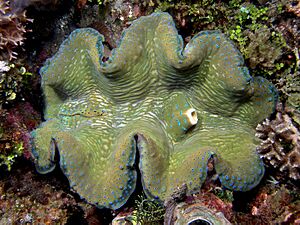
Conservationists are worried that people are overfishing giant clams. Their numbers in the wild have dropped a lot because they are harvested for food and for the aquarium trade. The giant clam is listed in Appendix II of the Convention on International Trade in Endangered Species (CITES). This means that international trade of the clams (including their parts) is controlled.
T. gigas has completely disappeared from some areas, like peninsular Malaysia. Other species, like T. derasa and Hippopus porcellanus, are now only found in Eastern Malaysia. Because of these local extinctions, giant clams have been reintroduced to places like Hawaii and Micronesia after advancements in clam farming. In the Philippines, clams that were restocked have successfully spread their own larvae several hundred meters away after just 10 years.
See also
- Platyceramus, the largest bivalve in the fossil record
Images for kids
-
Empty giant clam shell in the French National Museum of Natural History
-
Empty shell from the Aquarium Finisterrae in Spain
-
Giant clam in Waikiki Aquarium, Honolulu, Hawaii, United States



